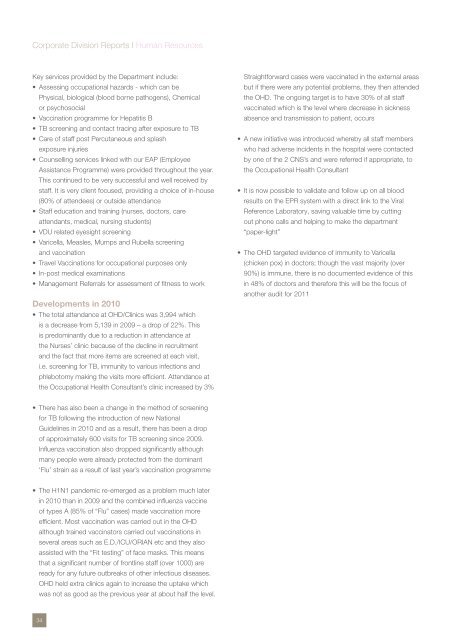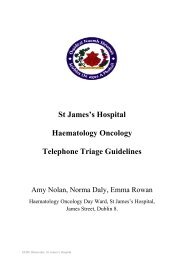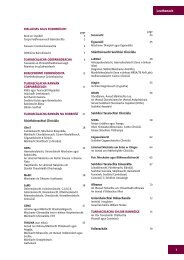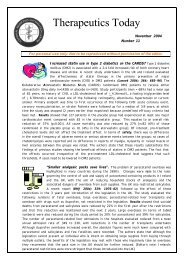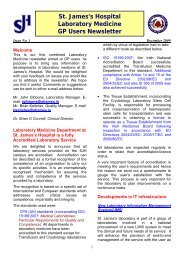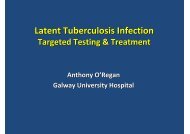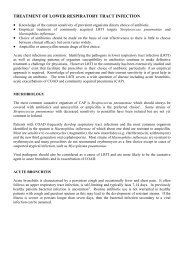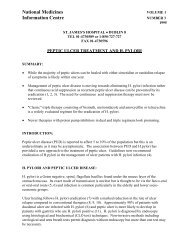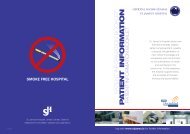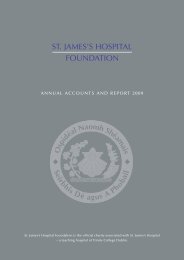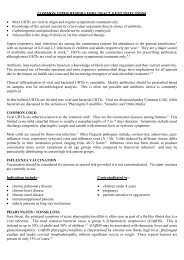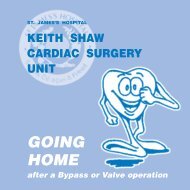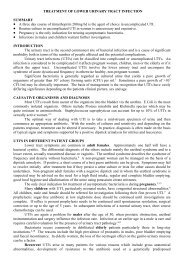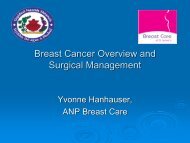Annual Report 2010 - St. James's Hospital
Annual Report 2010 - St. James's Hospital
Annual Report 2010 - St. James's Hospital
Create successful ePaper yourself
Turn your PDF publications into a flip-book with our unique Google optimized e-Paper software.
Corporate Division <strong>Report</strong>s I Human Resources<br />
Key services provided by the Department include:<br />
• Assessing occupational hazards - which can be<br />
Physical, biological (blood borne pathogens), Chemical<br />
or psychosocial<br />
• Vaccination programme for Hepatitis B<br />
• TB screening and contact tracing after exposure to TB<br />
• Care of staff post Percutaneous and splash<br />
exposure injuries<br />
• Counselling services linked with our EAP (Employee<br />
Assistance Programme) were provided throughout the year.<br />
This continued to be very successful and well received by<br />
staff. It is very client focused, providing a choice of in-house<br />
(80% of attendees) or outside attendance<br />
• <strong>St</strong>aff education and training (nurses, doctors, care<br />
attendants, medical, nursing students)<br />
• VDU related eyesight screening<br />
• Varicella, Measles, Mumps and Rubella screening<br />
and vaccination<br />
• Travel Vaccinations for occupational purposes only<br />
• In-post medical examinations<br />
• Management Referrals for assessment of fi tness to work<br />
Developments in <strong>2010</strong><br />
• The total attendance at OHD/Clinics was 3,994 which<br />
is a decrease from 5,139 in 2009 – a drop of 22%. This<br />
is predominantly due to a reduction in attendance at<br />
the Nurses’ clinic because of the decline in recruitment<br />
and the fact that more items are screened at each visit,<br />
i.e. screening for TB, immunity to various infections and<br />
phlebotomy making the visits more effi cient. Attendance at<br />
the Occupational Health Consultant’s clinic increased by 3%<br />
<strong>St</strong>raightforward cases were vaccinated in the external areas<br />
but if there were any potential problems, they then attended<br />
the OHD. The ongoing target is to have 30% of all staff<br />
vaccinated which is the level where decrease in sickness<br />
absence and transmission to patient, occurs<br />
• A new initiative was introduced whereby all staff members<br />
who had adverse incidents in the hospital were contacted<br />
by one of the 2 CNS’s and were referred if appropriate, to<br />
the Occupational Health Consultant<br />
• It is now possible to validate and follow up on all blood<br />
results on the EPR system with a direct link to the Viral<br />
Reference Laboratory, saving valuable time by cutting<br />
out phone calls and helping to make the department<br />
“paper-light”<br />
• The OHD targeted evidence of immunity to Varicella<br />
(chicken pox) in doctors; though the vast majority (over<br />
90%) is immune, there is no documented evidence of this<br />
in 48% of doctors and therefore this will be the focus of<br />
another audit for 2011<br />
• There has also been a change in the method of screening<br />
for TB following the introduction of new National<br />
Guidelines in <strong>2010</strong> and as a result, there has been a drop<br />
of approximately 600 visits for TB screening since 2009.<br />
Infl uenza vaccination also dropped signifi cantly although<br />
many people were already protected from the dominant<br />
‘Flu’ strain as a result of last year’s vaccination programme<br />
• The H1N1 pandemic re-emerged as a problem much later<br />
in <strong>2010</strong> than in 2009 and the combined infl uenza vaccine<br />
of types A (85% of “Flu” cases) made vaccination more<br />
effi cient. Most vaccination was carried out in the OHD<br />
although trained vaccinators carried out vaccinations in<br />
several areas such as E.D./ICU/ORIAN etc and they also<br />
assisted with the “Fit testing” of face masks. This means<br />
that a signifi cant number of frontline staff (over 1000) are<br />
ready for any future outbreaks of other infectious diseases.<br />
OHD held extra clinics again to increase the uptake which<br />
was not as good as the previous year at about half the level.<br />
34


